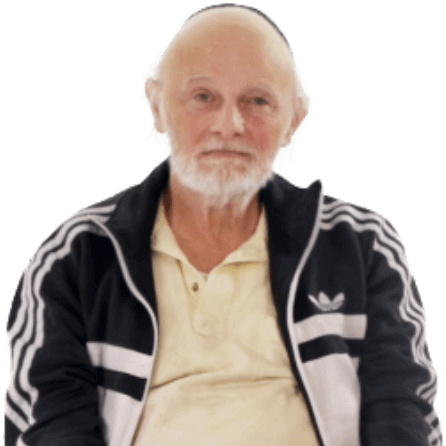INGREZZA real-world patient cases in tardive dyskinesia
See results with INGREZZA from real-world patients
Review tardive dyskinesia (TD) movements across a broad range of adult patients and see the effect of treatment with INGREZZA® (valbenazine) capsules.
Real-world patient cases
Real-world cases feature patients treated with INGREZZA in clinical practice, and not from the INGREZZA clinical trial program. Treatment decisions were based on healthcare providers’ clinical judgment.
These patients were compensated by Neurocrine Biosciences, Inc., and have consented to Neurocrine’s use of the videos and their protected health information.

Debra
Major depressive disorder



INGREZZA treatment:
- INGREZZA 40 mg (Weeks 0–5) then INGREZZA 80 mg (Weeks 5–6)a
Medical history:
- Woman in her 50s living with severe major depressive disorder
- Previously treated with anticholinergic
Relevant treatment:
- Second-generation antipsychotics, which resulted in TD
Relevant concomitant treatment at baseline:
- Aripiprazole, quetiapine, escitalopram, buspirone, amantadine
TD history:
- Developed choreoathetoid movements 6 months prior to treatment with INGREZZA
- Presented with predominant trunk movements and abnormal movements of mouth and lips
Note: Not all movements may be visible in these videos
INGREZZA treatment results:
- At 6 weeks, HCP noted torso and overall body movements were improved in intensity
- HCP notes patient did have some mouth and lip movements

Gloria
Schizoaffective disorder and depression





INGREZZA treatment:
- INGREZZA 40 mg (Week 1) then INGREZZA 80 mg (Weeks 2–6)a
Medical history:
- Woman in her 50s living with schizoaffective disorder and depression
- History of hospitalization, but circumstances were unknown
Relevant treatment:
- Second-generation antipsychotics, which resulted in TD
- Currently taking anticholinergic, but medical records were unavailable
Relevant concomitant treatment at baseline:
- Paliperidone palmitate 156 mg/QM, fluoxetine 40 mg/QD, benztropine 2 mg/BID
TD history:
- Presented with predominant jaw/mouth, hand, and foot movements
- Patient’s severe hand movement impacted self-feeding; she was also unable to communicate well due to tongue movements
Note: Not all movements may be visible in these videos
INGREZZA treatment results:
- At 2 weeks, symptoms showed improvement and HCP noted patient was more communicative
- Patient experienced somnolence
- At 4-week follow-up visit, HCP instructed patient to take INGREZZA HS
- At 6 weeks, patient’s family noted that movements were improved; HCP noted severe hand movements were reduced, enabling patient to self-feed

Dan
Schizoaffective disorder (bipolar type) and unspecified anxiety disorder





INGREZZA treatment:
- INGREZZA 40 mg (Weeks 0–8) then INGREZZA 80 mg (Weeks 9–16)a
Medical history:
- Man in his 20s living with schizoaffective disorder (bipolar type) & unspecified anxiety disorder
Relevant treatment:
- First-generation and second-generation antipsychotics, which resulted in TD
- Previously treated with anticholinergic for drug-induced movement disorder (DIMD)
Relevant concomitant treatment at baseline:
- Paliperidone palmitate 819 mg/Q3M, perphenazine 4 mg/BID, trihexyphenidyl HCl 2 mg/BID
TD history:
- Diagnosed with TD approximately 1 year prior to treatment with INGREZZA
- Presented with predominantly jaw, tongue, and hand movements
- Patient complained of jaw pain; his dentist found the pain unrelated to a joint or muscular issue
Note: Not all movements may be visible in these videos
INGREZZA treatment results:
- At 8 weeks, HCP noted movements were greatly improved from baseline
- At 16 weeks, HCP noted movements were “mild” and “minimal” for lips, perioral area, and jaw
- Patient noted that he no longer had jaw movement or pain due to jaw dyskinesia

Martin
Schizophrenia



INGREZZA treatment:
- INGREZZA 40 mg (1 month) then INGREZZA 80 mg (after 1 month)a
Medical history:
- Man in his 70s living with schizophrenia for over 30 years
Relevant treatment:
- First-generation antipsychotic, which resulted in TD
- Previously treated with anticholinergic for drug-induced movement disorder (DIMD), to no effect
Relevant concomitant treatment at baseline:
- Lorazepam 1 mg/TID, haloperidol 3 mg
TD history:
- Presented with primarily mouth movements as well as some hand movements
Note: Not all movements may be visible in these videos
INGREZZA treatment results:
- At 6 weeks, HCP noted symptoms were better controlled with less pronounced mouth movements

Felix
Schizoaffective disorder



INGREZZA treatment:
- INGREZZA 40 mg (Weeks 0–2) then INGREZZA 80 mg (Weeks 2–6)a
Medical history:
- Man in his 70s living independently with schizoaffective disorder for 30 years
Relevant treatment:
- First-generation antipsychotic, which resulted in TD
- Prior exposure to several first-generation antipsychotics
Relevant concomitant treatment at baseline:
- Haloperidol 5 mg/QD, amitriptyline 50 mg/HS, trifluoperazine 15 mg/QD
TD history:
- Developed abnormal movements of the mouth several years prior to treatment with INGREZZA
- Presented with primarily orobuccal movements as well as movements of the hands and feet
Note: Not all movements may be visible in these videos
INGREZZA treatment results:
- At 6 weeks, HCP noted symptoms look better controlled with less pronounced lip and jaw movements
- HCP notes patient did have some tongue and hand movements

Maureen
Bipolar disorder



INGREZZA treatment:
- INGREZZA 40 mg (Week 1) then INGREZZA 80 mg (Week 2–Month 31)a
Medical history:
- Woman in her 50s living with bipolar disorder
Relevant treatment:
- Second-generation antipsychotic, which resulted in TD
Relevant concomitant treatment at baseline:
- Quetiapine 400 mg/QD
TD history:
- Developed abnormal movements of the lips and jaw approximately 5 to 6 years before treatment with INGREZZA
- Presented with primarily orobuccal movements and jaw pain
Note: Not all movements may be visible in these videos
INGREZZA treatment results:
- At 31 months, HCP noted absence of orobuccal movements and jaw pain
THERAPEUTIC DOSE FROM DAY 1
The only VMAT2 inhibitor that offers an effective starting dosage you can adjust based on response and tolerability1
DOSING INFOREVIEW EFFICACY IN TD
Explore how INGREZZA reduced TD severity in both short- and long-term studies of adult patients with TD
EFFICACY IN TDCONNECT WITH A REPRESENTATIVE
Request an office visit from a Neurocrine representative for additional information, patient resources, or samples of INGREZZA
CONTACT A REP